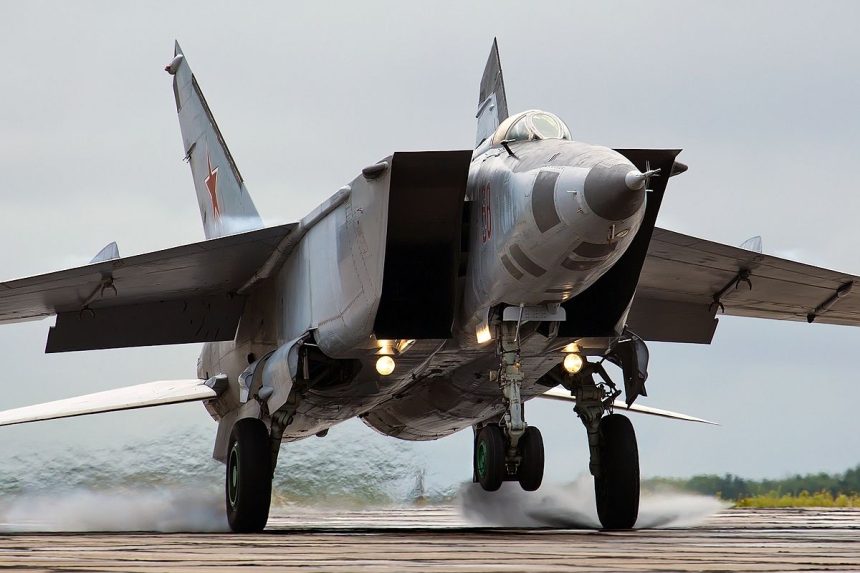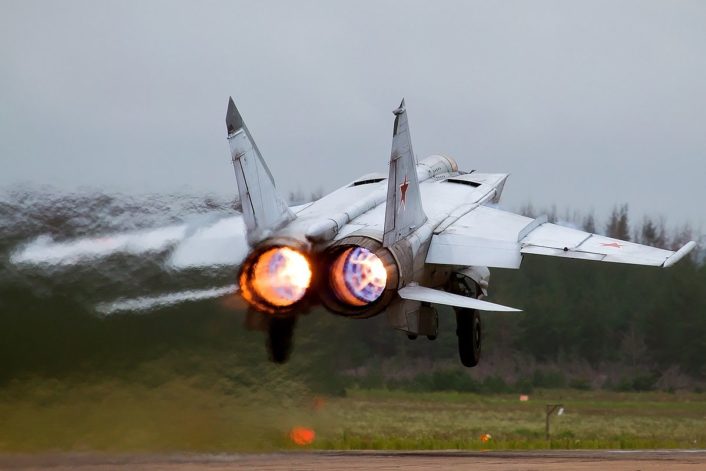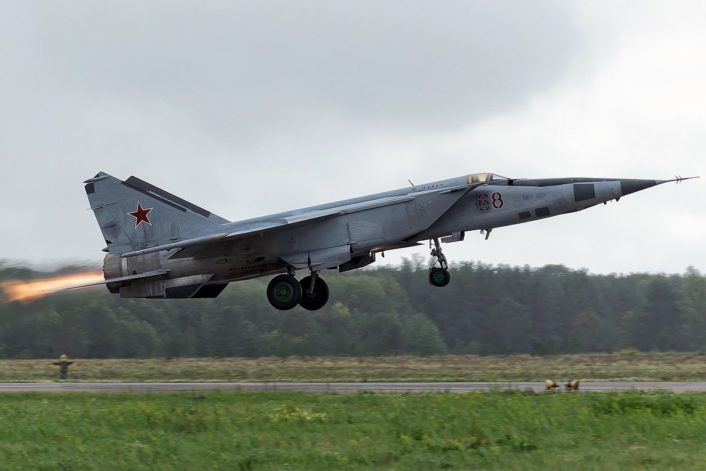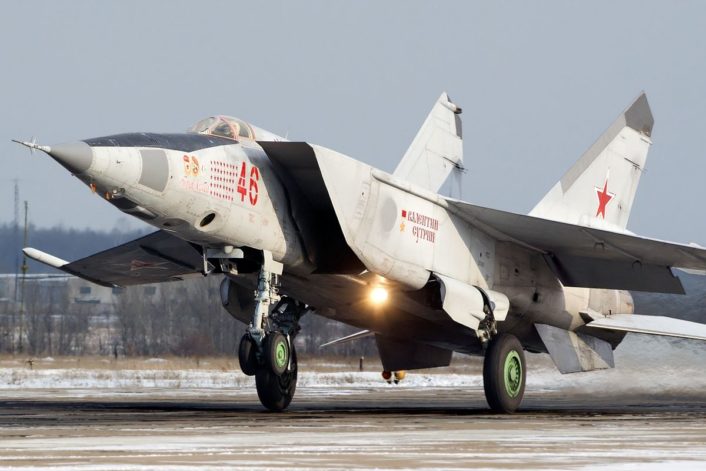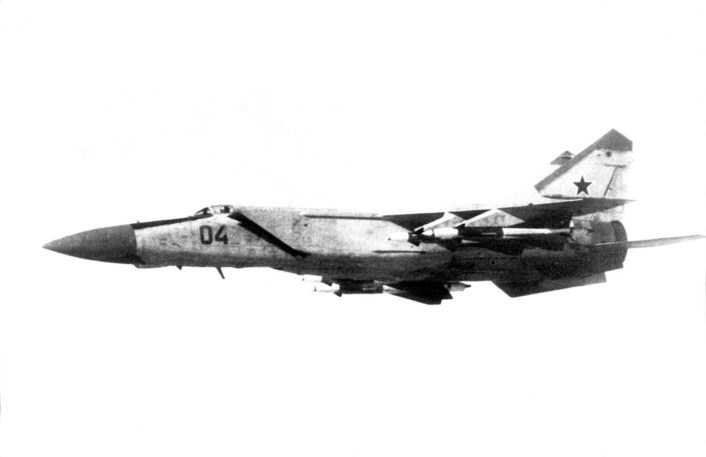OTD in 1976, Viktor Belenko, “stole” a MiG-25 and landed in Japan.
The then Lieutenant Belenko was a pilot with the 513th Fighter Regiment, 11th Air Army, based in Chuguyevka, Primorsky Krai, in the east of the country. When he brought his MiG-25 “Foxbat” to Hakodate he gave the Western intelligence officers the opportunity to give a first close look at one of the most secretive airplanes of those years: a supersonic interceptor featuring a powerful radar, four air-to-air missiles and a top speed above Mach 3.
In order to assist the American experts in evaluating the aircraft, Belenko brought with him the pilot’s manual for the MiG-25 “Foxbat”, expecting to assist American pilots in evaluating and testing the aircraft. Even if the Japanese government didn’t originally give full access to the plane, the Americans were later invited to examine the aircraft extensively: the MiG was dismantled for such purpose and later returned to the Soviet Union.
In his “MiG pilot” book (1983) John Barron claims that Viktor Belenko’s defection was completely voluntary and was the result of Belenko’s distrust on communist regime.
The MiG was delivered to Japan without the missiles, which were to be introduced in the Belenko’s training later on. The mission was launched earlier than initially planned, because the KGB was about to stop Viktor Ivanovich Belenko from defection.
Although pilot defections during the Cold War were not a rarity, what made Belenko’s defection unique was the fact that the MiG-25 was largely unknown in the West. This is the main point to bear in mind when thinking about Belenko and, unfortunately, this fact is often forgotten.
The ideological background for the events which took place in 1976 is deeply rooted in the beginnings of the post-war period. As the Cold War was in progress there were many incidents and crises which closely led to a confrontation between the two superpowers. One of these events was Francis Gary Powers’s U-2 spy flight on of May 1, 1960.
Power’s U-2 took off from USAF Peshawar Air Base in Pakistan for a GRAND SLAM mission, to investigate the Soviet missile and plutonium production plants. Targets were Sverdlovsk, Plesetsk (ICBM sites) and Mayak – a plutonium plant.
The U-2 was a plane designed to fly well above the Soviet air defense Surface to Air Missile systems. Its operational ceiling was out of the range of the Soviet interceptors and missiles but Powers’ flight was expected, all of the units and surface-to-air defenses were put on alert. The MiG pilots were ordered to ram the aircraft if necessary. The U-2 was eventually shot down by an S-75 Dvina missile near Degtayrsk in the Ural region. Because of high g-force Powers had no chance of reaching the airplane’s self-destruction button and had to eject.
What is interesting is the fact that SAM crews did not know that the plane had already been shot down because the MiGs’ IFF transponders were not updated (May 1st is a national holiday), therefore several Soviet aircraft were also shot down by S-75 rockets.
The political consequences of the spy flight were severe.
Shortly after the incident the Americans created a cover up story for Powers’ failure. NASA had announced in a very specific press release that the pilot, having lost consciousness due to the problems with the oxygen equipment, had strayed into the Soviet territory with his autopilot engaged while carrying out a weather flight.
On May 7, Khrushchev announced that Powers had survived the crash and, nine days later, on May 16, 1960, during a Four Powers Paris Summit meeting with Harald MacMillan, Charles de Gaulle and Dwight Eisenhower he called the U-2 incident an act of a “deliberate aggression.”
Eisenhower refused to apologize for the incident, claiming that the U-2 flight was not of aggressive nature, having only a purpose of ensuring US safety. The meeting collapsed. At the time, Eisenhower was a proponent of so-called Open-Sky Policy, according to which both sides would allow for reciprocal reconnaissance flights over their territories. Khrushchev did not agree. Powers was sentenced to 7 years of hard labor in a Gulag, but he was exchanged for a Russian spy Rudolf Abel on the famous Glinecke Bridge in Potsdam, connecting West and East Germany.
Gary Powers incident sparked the development of the American Oxcart programme, with the goal to design the SR-71 spy plane, which in addition to flying high, also flew very fast, out of the range of the Soviet missiles’ operational envelope.
What is more, a D-21 drone reconnaissance system was developed, to be carried by SR-71 as a parasite. The drone would be dropped, fly over the Soviet Union, return over the Pacific and drop the reconnaissance materials on a parachute.
Both these designs led to the development of a Soviet countermeasure – the MiG-25, known in NATO code as the Foxbat.
The main reason for the importance of Belenko‘s defection cannot be understood without going deeper in the aviation context of the event. The Cold War was the time when both sides used the nuclear armament as a psychological weapon. Therefore ways to deliver warheads were some of the priorities in the development in the field of military industry.
One of the ways to deliver warhead to its target was to use the strategic bomber. The bombers in the US – the B-52s – were subsonic, and could have been easily intercepted by the MiG-21, which was capable of reaching speeds of Mach number up to Mach 2 and altitudes of 60,000 feet.
Problems began to emerge when the B-58 Hustler was designed. This plane was capable of flying with the same level of performance as any MiG-21, which for the Soviet designers meant they had to look for a better countermeasure.
The Strategic Air Command of the United States Air Force at the time was into creating a nuclear-powered bomber of infinite range. The project had been dropped in 1964 when North American aviation announced that it could build a bomber capable of attaining speeds of Mach 3 throughout the entire length of its mission.
Secondly, after the failure of U-2 spy plane, launched the Oxcart program, which lead to the development of Mach 3 strategic reconnaissance aircraft, SR-71.
That put the Moscow designers on alert, and an assignment was given to the design bureaus of MiG (Mikoyan and Gurevich) and Sukhoi to develop a countermeasure.
The surface-to-air missiles were considered insufficient. The aim was to develop a single-seat interceptor capable of attaining extremely high speeds and altitudes.
New problems for the Soviet scientists emerged, such as thermodynamic heating, leading to immense development of the Moscow research institute, TsAGI – transliteration of the Russian abbreviation which stands for Центра́льный аэрогидродинами́ческий институ́т (ЦАГИ) – Central Aero-Hydrodynamic Institute. Mikhail Gurevich was the leader of the MiG-25 project.
According to Discovery Channel’s TV series Wings of the Red Star many Western experts argue that the Foxbat was inspired by the North American Aviation A-5 Vigilante. The design programme for MiG-25 was founded in 1958. The basic design of E-155 which later became MiG-25 was the work of Artion Mikoyan.
The E-155, the prototype of what was to become Foxbat was propelled by two large turbojet engines designed by Tumansky. The prototype itself was designed in the period of 1961-1962.
No aluminum, so popular in the West at the time, was used for construction. Steel and nickel alloys were used instead, with limited use of titanium on leading edges and places where heat loads were expected to be high.
The aircraft had to be light, to that extent that weight was traded for strength. The G-load it could withstand was only 5 g, two times less than other fighters which were designed to fight in close combat.
The maiden flight of E-155 was made by famous MiG test pilot, Alexander Fedotov on May 1, 1964.
The MiG-25’s mission as an interceptor required development of fire control system which would be able to work at the speeds the plane could reach.
The radar on the plane, RP-25 Smerch, designated in the NATO nomenclature as Foxfire, 1,100 pounds in weight, was the largest device of this type at the time. According to Barron, the radar was very powerful (600 kilowatts), as
“[Belenko] also dared not touch the radar switch because the impulses from the MiG-25 radar were so powerful, they could kill a rabbit at a thousand meters. Hence, it was a crime to activate the radar on the ground.”
Its purpose was to burn through any jamming systems known at the time and to provide a stable lock-on allowing the pilot to use the air-to-air missiles that Foxbat was carrying.
Also in May of 1964 the XB-70 aircraft was made a research airplane, and presented to the public in Palmdale, California, after being canceled three times (in 1959, 1960 and in 1961). At same time, the U-2 missions were still a danger, so as the SR-71, US Air Force ultimate Mach 3 spy plane. For these reasons the development of Foxbat was not canceled.
Mikoyan left his design bureau in March 1964 for health reasons. Never had he an opportunity to see the MiG-25 enter service dying in December from the heart attack.
In March 1965 the first public announcements of the plane’s performance were made, which was that it completed 150 kilometers closed circuit flight at the speed of 1,400 miles per hour.
The Foxbat made its first public appearance at the airshow organized in connection with the celebration of the 50th anniversary of the October Revolution on Jul. 9, 1967 on the Domodedovo airfield. When three MiG-25s appeared in the sky the show announcer referred to them as “Interceptors capable of Mach 3”.
Both the Western experts and Russians were puzzled, as even in the Soviet Russia there was almost no information about the MiG-25 available to the public whatsoever, up until 1972.
Besides being an interceptor, the Mig-25 was also a high altitude reconnaissance aircraft. It was operated in the conditions of direct radio communication with the ground and was capable of taking photographs of whole United Kingdom within one flight.
The West had an opportunity to see what the aircraft was capable of in a proxy war between Israel and Egypt.
Four MiGs, referred to as X-500, were shipped to Egypt in fall 1971. The Egyptians were forbidden to come close to them, and even though the aircraft had Egyptian markings, they were flown by Soviet pilots and serviced by Soviet crews.
When one of the Israeli F-4 Phantom fighters tried to intercept the MiG reconnaissance aircraft at Mach 2,5, the MiG simply accelerated to Mach 3.2 and disappeared.
The MiG-25 engines were capable of producing 12,500 kG each. The design assumptions of the construction were not to create a good close combat fighter, but to propel it throughout the airspace as fast as possible.
In the late 1960s the USA developed the F-15 which was a fruit of the vague understanding of what MiG-25 was. That understanding was based on the speed and altitude records Foxbat had broken (see below).
The Western experts assumed that it was faster in straight line than expected. They also thought that it was made of lightweight, modern composite materials and that it was powered by modern turbofan engines. It was also believed to have a long-range and good close air combat capabilities.
As a result of that, American engineers designed the ultimate fighter jet, which was very complex, and due to that – quite costly. In the beginning of its existence it broke many of the climb records established earlier by hte Foxbat.
It was late 1972 when F-15 entered service, and it was long until 1976 for the MiG to remain a mystery.
On Sept. 6, 1976, when Viktor Belenko defected taking off from the Sokolovka airbase and landing in Japan, the Western perception of Foxbat changed.
It turned out that the airplane was heavier and simpler in construction than expected, hence it had shorter range. It was far from being a close combat jet with its rugged construction. It also had very poor low-speed capabilities.
As Peter Ustinov of the Wings of the Red Star TV series summarizes: “MiG-25 was indeed an extraordinary machine, but not the one the West had imagined.”
Nevertheless the simplicity of Foxbat could not stop it from breaking many world records, nor could the Americans at the time.
The prototypes were made lighter and their purpose was to break several records. As it is stated in the classification of FAI (International Aeronautical Federation), Foxbat belonged to the category C1 (III) which specifies jet powered aircraft with unlimited take-off weight.
The records broken by Foxbat were of various nature.
They included: speed record on a 1,000 km circuit by chief MiG test pilot Alexander Fedotov: 2319,12 km/h on Mar. 16, 1965; the Foxbat broke several time-to-height records, for example climbing to 20,000 m in 2 minutes 49,8 seconds. The MiG-25 also set several absolute world records that still stand. Absolute world altitude records with 1,000 kg payload, and without payload: 35,230 m and 36,240 m respectively were also set.
As already explained, the West had almost no knowledge of MiG-25 whatsoever until 1971, and very poor knowledge by September 1976 when Belenko defected.
It was a great surprise, and present for the Western experts when Belenko flew a brand new MiG-25 to a Japanese airfield.
At first the Soviet officers at Sokolovka airbase, where Belenko was stationed, thought that it was navigation systems problem that occurred and lead to the event. The defection, however, was preplanned and premeditated.
Several authors say that Belenko, had been an aviation enthusiast from his earliest childhood.
He received his flight training in order to become a flying instructor and devoted most of his time to learning and perfecting his flying craftsmanship.
He got a job as an instructor in Amarvir Pilot School, flying Sukhoi Su-15 planes, always being a top notch airman. It was in the beginning of the 1970s when he heard about a MiG-25 for the first time.
Almost immediately, wanting to learn about the new plane, he asked for transfer to flight training on Foxbat in 1972. The unit he applied to was Rostov, near Iran, but he was soon moved to the far east, to Sokolovka, the 530th Fighter Regiment.
The permission for transfer given by the commander being an exception in those times was justified with the Belenko’s great interest in the modern air technology. His records were flawless, so he was selected, and he was appointed a party secretary of the squadron.
Belenko’s training program progressed without any trouble. After the individual flights program ended the group flights began. The group flights started at the end of August and were to be conducted for one month.
On Sept. 6, 1976 Belenko walked his child to the kindergarten and went to the base to fly.
The weather conditions were good for flying – the cloudiness was of about 7/10 with the lower cloud surface at 1,500-2,000 meters and upper at 5,000 meters. Take-off was to take place at 12:50.
Soon after the take-off Belenko reported engine problems and separated from the group. He dropped to an altitude of 50 m above the sea, so no problems that usually occur in a low-level flight were present. He was flying low, so the radars could not track him. The direction the plane was going was eastward. Directly towards the Japanese archipelago.
Getting closer to the shore Belenko climbed to 6,700 m, waiting for the reaction of the Japanese air defense.
370 kilometers from the island he was finally spotted by the radars. The Japanese at Chitose airbase scrambled a pair F-4J fighters to intercept him. Knowing that he had been detected he descended again but he soon entered the clouds, experiencing difficulties in navigation.
At 13:52 he spotted an airfield and attempted a landing, but had to abort it and go around because of a Boeing 727 airliner taking off. According to his assessment, the airstrip was a bit shorter from what he had seen on military airfields. He made a long landing, overshooting the runway and rolling about 240 meters beyond the threshold.
After getting out of the cockpit he spotted the name of the airfield. Unfortunately it was not a military base, but civilian Hoktado strip. Nevertheless, Belenko was in Japan, which was his main objective. Just after getting out of the cockpit he made a warning shot and warned the Japanese not to come close to the plane because it was secured with explosives (at the time the Soviet Air Force used to secure the MiG-25 from getting into the Western hands by using explosives and self-destruction system).
He also asked the personnel to cover the aircraft in such a way that the Soviet markings were not visible. Then, he asked to be put in contact with the US Air Force representation. The airfield was closed down for five hours. Belenko asked for a political asylum.
The time between the afternoon of September 6th and 7th was very eventful.
The media showed a large interest in the incident and disseminated the news all across the Western world. Aeroflot sent a delegation, but they were not allowed to see nor to come close to the Foxbat.
Diplomacy was a major problem. In order to justify keeping the pilot and plane on the Japanese territory the authorities accused Belenko of illegal border trespassing.
The plane was moved to a hangar and afterwards was transported to military airbase in Hyakuri, located 80km north from Tokyo. On Sept. 19 a C-5 Galaxy cargo plane was brought from the US in order to transport the MiG-25; eleven experts from Wright-Patterson AFB were brought in order to examine the aircraft.
Also 64 Japanese experts took part in the examination. The aircraft was partially dismantled and transported in escort of F-4J and F-104J fighters.
The examination included infra-red photos of Foxbat with the engines working at full military power. It was essential for western air-to-air missiles designers to know the heat spectrum of the engines, so that they could develop missile guidance systems according to the characteristics of the Foxbat engines.
The diplomatic struggle went on. The official statement of the Japanese was that the plane would be returned to the Soviets but no sooner than Oct. 5, 1976. Due to the fact that samples of materials were taken from the wings the Foxbat could not go back by air.
It was dismantled again and sent back on a container ship in parts, in 13 containers. The Japanese secured the containers so that the Soviet personnel would not do the review of the plane in the daylight.
But the Russian methodology was unknown to the Japanese. The personnel had opened the containers with crowbars and it turned out that some equipment was still in the hands of the West. The Soviets asked the West to pay for the missing aircraft instrumentation and avionics. The Japanese in a reply asked the Russians to pay for transport and formalities.
Belenko’s family was detained and KGB started an investigation. A personal diary in which fuel calculations were carried out was found in Belenko’s flat.
It was also found out that the pilot was in Moscow a week prior to the deception.
All these factors suggested that the incident was a long preplanned operation of the American intelligence as Belenko could have met a US agent in Moscow.
What is more, the Soviet pilot very often used the confidential library of the airbase, more often than other pilots. It was supposed that he might have been taking photos of the MiG-25 manual.
After Belenko arrived he was isolated from the third parties.
He got a political asylum in the USA, where he started working in an aviation company. Afterwards, in many interviews, like in one for Full Context magazine, he said that the main reason behind the defection was to get away from the communism.
He received American citizenship and opened his own company. He got married to an American woman, with whom he had 3 children. According to Barron’s book his family life in USSR was going towards a bitter end – a divorce – so he fled to the US.
After publishing this article we received an email from one of our readers who provided some more behind the scenes details. Here’s what he’s written to us:
Actually, they did, and Russia was totally unaware of it. It was rolled into a hangar, dismantled, and flown to Area 51 by C-5A Galaxy, where it was totally examined, taken apart, reassembled, and flown by Victor Belenko against our first line fighters of the time. It was then disassembled, crated, loaded back onto the C-5, and flown back to Japan, where it was placed on the dock to await a Russian freighter’s pick-up.
We expected to find high tech alloys used for the wings, but the rust through the paint revealed they were steel. Where we expected high tech electronics, we found vacuum tube electronics.
You must remember that Russia builds for durability, and survival under war-time conditions. Just like their AK-47 Automatic rifle…bullet proof, easy to manufacture, and repair under war conditions. Which is easier to construct, and repair during wartime..high tech, or low-tech items? You’ll find the inside of Antanov’s giant aircraft made the same way, especially loading ramps, which are hollow, with an aluminum thin covering and internal ribs, with a reverse dimple texture. Hydraulics actually glass jars !!
Area 51 was the site of many Russian MiG tests, obtained from many different sources. we had a number of pilots versed in, and trained in MiG operations and evaluations.
Yes, Japan DID allow the removal, and testing, by us, of Belenko’s MiG 25..but it was highly secret.

